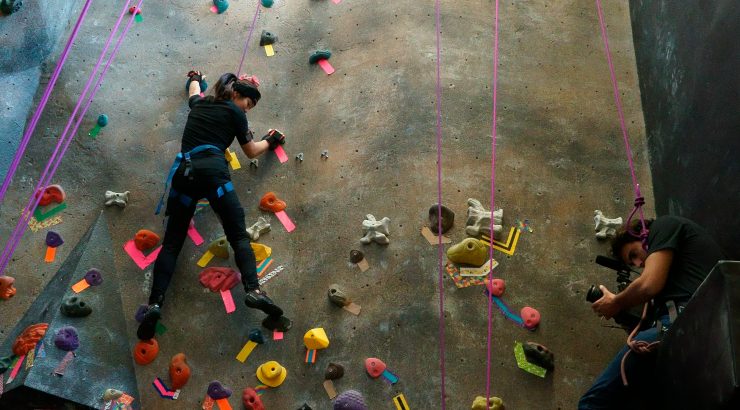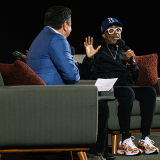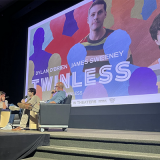Using Motion Capture to Climb Out of the Uncanny Valley
August 2, 2016
EDITOR’S NOTE: We have so many fantastic programs here at Dodge College that sometimes stories get lost in the shuffle. We wanted to highlight this great piece about one of our latest interterm classes that worked in motion capture. Since VR is very big at our school right now, we wanted to show just how some of these students got into it.
At the base of the rock climbing wall in Chapman’s Sandhu Conference Center, a group of film students huddle around a laptop, staring at an image of a digital stick figure. Behind them is a young woman, dressed in a black suit with bright orange sensors.
“Okay, go ahead and get into position,” says director Jeff Hodges, BFA/FP ‘15. The young woman walks over to the rock climbing wall, the wire frame figure on the screen mimicking her movements. “Quiet on the set!” the director calls out. “And… action!”
Slowly, the young woman starts climbing the wall. As she does, the image of the stick figure on the screen climbs as well. The energy in the room is electric, because even though this is the third time that Roy Finch’s Location Filmmaking class has used the Xsens motion capture system, it’s the first time that the image on the screen has left the ground.
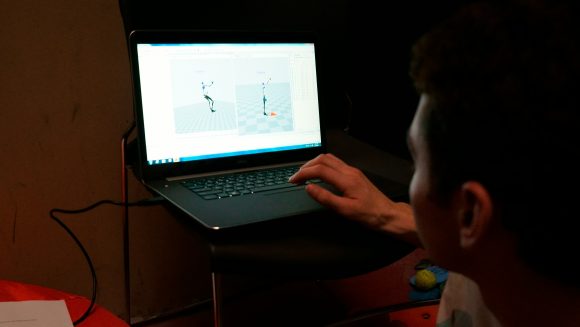
Kc Wayland, digital applications specialist for Dodge College, explains. “With our current motion capture suit, if an actor tries to jump or walk on an elevated surface, the floor in the computer comes with them. This suit, which was loaned to us by Xsens and which we’re going to upgrade to later this year, uses barometric pressure sensors to know where the actor is in relation to the floor.”
The purpose of the performance is to bring to life the story of
Ecila
, a short film about a young girl who stumbles into an animated world as part of a journey to finding self-confidence.
“Jeff Hodges came to me in September and wanted to do something for Interterm that was more ambitious than previous years,” says Seth Josephson, a writer and co-director on the film. “He wanted to combine motion capture with green screen and live animation.”
Ecila
has been an ambitious project for Dodge College. “Normally, there are two or three smaller productions for Location Filmmaking,” says Josephson. “Instead, we had a massive crew dedicated solely to our project, a much larger budget, and a lot more time to work on the production, so it was much more like working on a professional film.”
“Any time you try to do something this ambitious, people will tell you that you shouldn’t,” says Hodges. “The flipside, though, is that in order to do something amazing, you have to do something people tell you is impossible. We’ve had some problems, sure, but we’ve turned what was once a straightforward action/adventure story into a character piece about confidence and confronting something you don’t quite understand.”
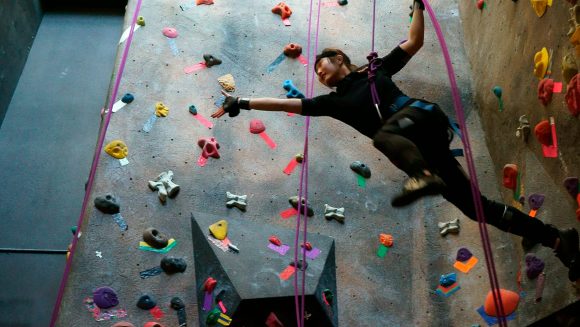
Even though the production has wrapped, the students are still working diligently to bring their story to life. In March, Hodges traveled to the Game Developers Conference in San Francisco to meet with professionals in the motion capture industry.
“I had a great conversation with director Jimmy Livingstone about how to avoid what’s known in the business as the ‘uncanny valley syndrome,’” says Hodges. “This is where a character appears realistic, but something is off and it evokes a feeling of revulsion in audiences. He explained that a character’s performance can’t be the exaggerated movement that you see in most animated films. It has to be more focused. The actor has to concentrate on what they’re doing and why they’re doing it. It’s a delicate balance to strike, but I’m excited to take what I’ve learned and apply it to our film.”
